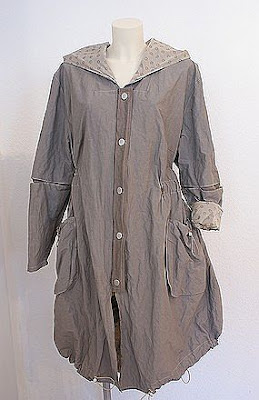The last time I posted about these wonderful French patterns, Au Bonheurs des Petites Mains, I had just received three of them and had begun to translate the instructions. I even started a French-English sewing glossary (which I have been adding to). :)
I was primarily focusing on this raincoat pattern:
Which was the most complex of the three I had ordered. From my painstaking translation, I managed to learn that this coat has the following features:
- A front zipper underneath a snap placket.
- A back gusset, ending at the CB hem, which can be zippered closed.
- Front pockets, which have a gusset along the curved portion of the pocket only (not along the straight edge of the pocket, which is sewn into the side seam). The pockets are gathered at the top with elastic.
- Gussets in the sleeves at the elbows.
- Elastic around the hem (excluding the back gusset).
- Elastic at the waist, though not all the way around – it ends several inches short of CF.
- A full lining.
- The name of the pattern company is Au Bonheur des Petites Mains. (I wasn't sure if this was merely descriptive text or actually the name of the pattern company.) I asked my friend if it really did mean "Good Times of the Little Hands" which is how it literally translates. (And which sounds a bit salacious to my ears. :) ) She explained that in the French couture houses, the dressmakers are called "Les Petites Mains", so a more accurate translation is "Good Times of the Dressmakers" or "Happiness of the Dressmakers" or something along those lines. Now that is a charming concept and I love it! :)
- The instructions are sadly lacking, at times misleading, and certainly incomplete. I have heard this is not unusual for French patterns, since most assume that the user of the patterns knows how to sew.
- The garment in the photo (shown above) clearly shows round elastic peeking out at the top-center of the pockets, secured with a toggle. However, neither the pattern, nor the supply list, make any mention of this feature. It calls for 1cm wide elastic for the pockets (between 1/4" and 3/8"). It does not mention round elastic or toggles. But it does instruct you to make a buttonhole at the top of the pocket, 4cm in (approx 1.5 inches) from the straight edge. However, it doesn't use that buttonhole. It instructs you to use the 1cm elastic, catching the ends at the sides of the pocket, and encasing the elastic. Also, if you want to use the buttonhole for a round elastic, 4cm is not the center of the pocket. It is very off-center, which does not seem correct if you look at the photo.
- The garment in the photo also shows round elastic with toggles at the hem of the jacket. The instructions do not mention this but instruct you to use 1cm elastic at the hem, which is entirely encased.
- The sleeve is in two pieces, a top piece and a bottom piece, and a gusset is inserted between them. You are then instructed to insert a small piece of elastic, joining the top and bottom, at four marked points (two on each sleeve). You are then instructed to insert a snap at this same location, to somehow join the top sleeve to the bottom sleeve. This bit really confused my French friend, who, after reading through it several times, advised me to ignore it. I will wing this part. :)
- The fact that the garment in the photo uses a different fabric for the front band and the sleeve gussets is not mentioned.
- The construction of the front placket was a little confusing, and it doesn't really explain how the separating zipper is installed. I am assuming this will become more clear as I work through it.
- I found some minor errors on the pattern pieces themselves. For example, on the (American) football-shaped gusset for the sleeve, it says to cut two on fold, when it must mean to cut two – the piece has no straight edges to put on the fold. :)
I have measured the pattern and determined that a size 52 (the largest size provided for this pattern) should be adequate. The dart in the pattern even seems to be the right location for me. I have traced the pattern off and hope to start the muslin tomorrow. I can't wait to get started. I will keep you posted. :)
I want to give a huge shout out and a thank you to Laurence, my French sewing friend. Thanks so much, Laurence, for your patient help!!! (It's pronounced La-Wrans, with the emphasis on the second syllable which starts with that wonderful rolled French R in the back of your mouth. She speaks German, and "Architect", too. ;) )
